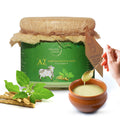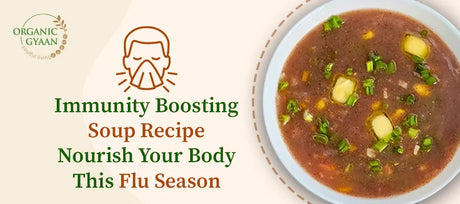Our browntop millet flour, made from whole, unpolished browntop millet (also known as Andu Korralu), is more than just a gluten-free alternative- it’s a powerful, healing flour that works gently from within. Known in ancient food traditions as a cleansing grain, browntop millet supports digestion, detoxification, and gut health, making it an excellent choice for daily nourishment and deep, natural healing.
What sets our browntop millet flour apart is the way it’s prepared. Most flours are made from untreated, dry grains that can be tough on the digestive system. But we take a more thoughtful route. Our millet is soaked, dehydrated at low temperatures, and stone-ground to preserve its natural nutrients and improve bioavailability. The result? A clean, smooth, and easy-to-digest brown millet flour that truly supports your body from the inside out.
Why Choose Our Activated Browntop Millet Flour?
-
Made from Whole, Unpolished Browntop Millet – Retains all natural fiber, antioxidants, and minerals.
-
Soaked & Activated for Better Absorption – Reduces anti-nutrients for improved digestion and nutrient uptake.
-
Stone-Ground for Maximum Nutrition – Preserves taste, texture, and essential nutrients.
Benefits of Browntop Millet Flour
1. Supports Natural Detoxification
Regular consumption helps remove toxins from the body, promoting better digestion and internal balance.
2. Encourages Gut Health & Microbiome Balance
Rich in prebiotic fiber, it feeds healthy gut bacteria, aiding in smooth digestion and reducing bloating.
3. Aids Pancreatic & Gastric Health
Known for its digestive-soothing properties, browntop millet flour helps ease acidity, regulate gastric function, and support pancreatic enzymes.
4. Supports Weight Management
With 4x more fiber than rice, this flour keeps you fuller for longer, curbing cravings and promoting a balanced metabolism.
5. Helps Maintain Healthy Blood Sugar Levels
Browntop millet flour has a low glycemic index, making it a smart choice for diabetes management and preventing sugar spikes.
6. Rich in Antioxidants for Disease Prevention
Packed with natural antioxidants, browntop millet helps fight inflammation and may reduce the risk of chronic diseases, including cancer-related conditions.
7. Sustainable & Water-Efficient
Grown with minimal water, this millet is an eco-friendly choice for both your health and the environment.
How to Use Browntop Millet Flour
Browntop millet flour has a mild, earthy taste and is extremely versatile in the kitchen. It’s perfect for both traditional Indian dishes and modern, clean-eating recipes.
Great for making:
- Rotis and parathas
- Savory pancakes and cheelas
- Millet-based cookies or crackers
- Detox-friendly porridge or laddus
-
Baby-friendly soft foods
Whether you're preparing a simple daily meal or following a cleansing routine, this flour offers nourishment you can feel good about. It also pairs well with other traditional flours like kangni atta for nutrient diversity.
How to Make Soft Rotis with Browntop Millet Flour
- Mix the flour with warm water and knead into a soft dough.
- Add 1 tablespoon of A2 Gir Cow Ghee after kneading to enhance softness and nutrition.
- Let the dough rest for 15–30 minutes if time allows.
- Roll gently and cook evenly on a hot tawa.
These rotis turn out light, satisfying, and easy on digestion—perfect for daily meals or detox plans using hari kangni atta or browntop millet flour.
Why Buy From Us?
-
100% Organic & Unpolished – We preserve the grain’s integrity to deliver true nourishment.
-
No Preservatives or Additives – Just clean, pure millet flour with nothing hidden.
-
Sustainably Sourced – We work with conscious farmers who prioritize soil health and regenerative practices.
-
Recommended by Natural Health Experts – Trusted for detox, gut healing, and long-term wellness protocols.
If you’re looking for a flour that does more than just fill your plate- one that gently cleanses, restores, and supports your body- browntop millet flour is the grain you’ve been waiting for.
Make it a part of your everyday diet, and feel the difference from within.
FAQ
1. What is brown top millet flour?
Brown top millet flour is a type of flour made from the ground seeds of the brown top millet plant. It is a gluten-free and nutritious alternative to wheat flour.
2. What are the benefits of using brown top millet flour?
Brown top millet flour is high in fiber, protein, and essential nutrients like iron and magnesium. It is also gluten-free, which makes it a great option for people with celiac disease or gluten sensitivity.
3. How do I use brown top millet flour in cooking and baking?
Brown top millet flour can be used in a variety of recipes, including bread, muffins, pancakes, and more. It has a slightly nutty flavor that can enhance the taste of your baked goods.
4. Can I use brown top millet flour as a 1:1 substitute for wheat flour?
Brown top millet flour can be used as a substitute for wheat flour in some recipes, but it may require some adjustments to the recipe to achieve the desired texture and flavor.
5. How can I make soft rotis using browntop millet flour?
To prevent rotis from breaking and to improve softness, add 1–2 teaspoons of psyllium husk (Isabgol) while kneading browntop millet flour. Psyllium improves binding, makes the dough flexible, and results in smoother, easier-to-roll rotis.



































